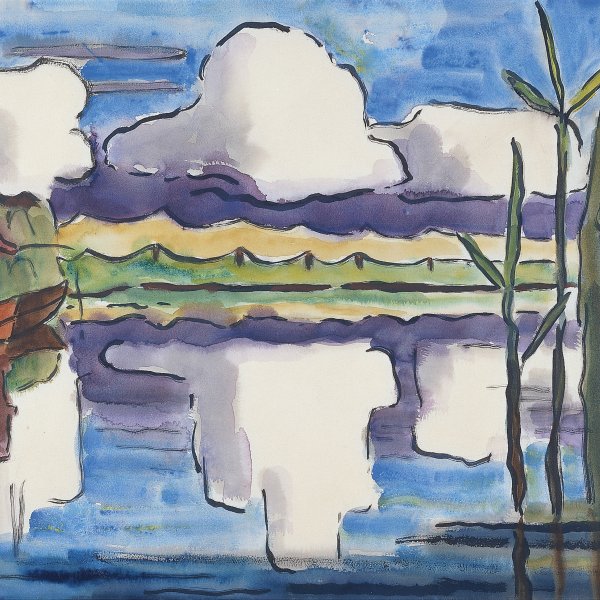Sun over Pine Forest
Sun over Pine Forest was originally owned by the Hamburg collector and art historian Dr Wilhelm Niemeyer, who was one of the most important of Schmidt-Rottluff's friends and patrons during the years leading up to the First World War. Niemeyer had been the driving force behind the exhibitions of the West German Sonderbund, held from 1909 onwards, at which works by modern French artists-including Braque, Picasso and other Cubist painters-were shown. Schmidt-Rottluff must have encountered French Cubist works in the original by 1912, at the latest, at the Cologne Sonderbund exhibition-that is, a whole year before Sun over Pine Forest was painted. But he probably knew a good deal about the latest development of French art long before that date, thanks to his acquaintance with Niemeyer. The Cubists' influence is clearly seen in this painting of sand dunes and pine trees, which, with its flat colours, geometric shapes and palette composed largely of ochres and reddish-browns, may be seen as a direct response to what one writer has called the "challenge of Cubism."
The picture also bears an obvious resemblance to another work in the Thyssen-Bornemisza collection, Max Pechstein's Summer in Nidden of 1919-1920, which exhibits a very similar composition and is likewise dominated by a blazing, non-naturalistically depicted sun and the gaunt, hieratic shapes of the trees. In fact, both pictures were painted in much the same location, close to the fishing village of Nidden on the East Baltic coast. Nidden itself stands on what is known as the "Kuhrische Nehrung", a long, narrow strip of land dividing the sea from a shallow lagoon, the Haff. This region is now part of Lithuania, but up to the end of the Second World War it still belonged to East Prussia and had, long before the turn of the century, become a popular place of pilgrimage for German artists. With its simple fisher-folk, its rolling sand-dunes and forests of pine and fir inhabited by elk and deer, it was, in many ways, the epitome of those rural artists' colonies such as Pont-Aven or Worpswede that played such an important role in the development of early modern art. This remote environment not only provided painters with an unspoiled landscape and a wealth of picturesque subjects to depict. They also saw in the continual struggle for survival waged by the primitive fishing community an image of the unity of man and nature, untouched by "progress", the dubious benefits of civilisation.
In fact, it was Pechstein who had first introduced Schmidt-Rottluff to Nidden, having visited the area for the first time in the summer of 1909. He returned there two years later, and on both occasions lodged with the fisherman Martin Sakuth, who also befriended Schmidt-Rottluff during the latter's 1913 visit. Schmidt-Rottluff's stay, which lasted from May to August 1913, produced a rich crop of at least thirty paintings: depictions of the coastline and fishing boats, studies of figures in a landscape setting and views of the pine forests surrounding the scattered fishermen's cottages of Nidden itself. It is to this last category that the present picture belongs.
Peter Vergo








